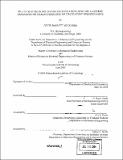| dc.contributor.advisor | H. Harry Asada. | en_US |
| dc.contributor.author | McCombie, Devin Barnett, 1972- | en_US |
| dc.contributor.other | Massachusetts Institute of Technology. Dept. of Electrical Engineering and Computer Science. | en_US |
| dc.date.accessioned | 2005-06-02T19:18:25Z | |
| dc.date.available | 2005-06-02T19:18:25Z | |
| dc.date.copyright | 2004 | en_US |
| dc.date.issued | 2004 | en_US |
| dc.identifier.uri | http://hdl.handle.net/1721.1/17950 | |
| dc.description | Thesis (S.M.)--Massachusetts Institute of Technology, Dept. of Mechanical Engineering; and, (S.M.)--Massachusetts Institute of Technology, Dept. of Electrical Engineering and Computer Science, 2004. | en_US |
| dc.description | Includes bibliographical references (leaves 53-54). | en_US |
| dc.description.abstract | A new tool for real-time characterization of both systemic and local circulatory hemodynamics has been developed. Given two peripheral circulatory waveform measurements this new signal-processing algorithm generates two low order models that represent the distinct branch dynamic behavior associated with the measured circulatory signals. The framework for this methodology is based on a multi-channel blind system identification technique that has been reformulated to use a Laguerre basis function series expansion. The truncated Laguerre series expansion allows a highly compact representation of the cardiovascular dynamics. This new algorithm has been applied to experimental arterial blood pressure measurements derived from a swine model and shown to consistently provide accurate identification of the vascular hemodynamics. The parameters of the circulatory dynamics that are quantified in real-time via this newly developed algorithm, Laguerre Model Blind System Identification (LaMBSI), can be used to identify or quantify systemic and local cardiovascular features of interest. The LaMBSI algorithm identifies a set of six parameters per channel when applied to measured circulatory signals, 5 distinct model coefficients plus 1 common Laguerre basis pole shared by both channels. The two sets of identified parameters can be treated as feature vectors and standard statistical techniques can be used to extract information from this compact time series of data. In this thesis, a multi-parameter linear regression is used to predict cardiac output based on the LaMBSI feature vectors identified from two pulsatile arterial pressure signals. The promising results from this linear regression model serves as a proof-of-principle that the | en_US |
| dc.description.abstract | (cont.) hemodynamic parameters identified from two distinct circulatory waveform signals using the LaMBSI algorithm can be used to characterize systemic or global parameters within the circulatory system. | en_US |
| dc.description.statementofresponsibility | by Devin Barnett McCombie. | en_US |
| dc.format.extent | 62 leaves | en_US |
| dc.format.extent | 3166280 bytes | |
| dc.format.extent | 3166086 bytes | |
| dc.format.mimetype | application/pdf | |
| dc.format.mimetype | application/pdf | |
| dc.language.iso | eng | en_US |
| dc.publisher | Massachusetts Institute of Technology | en_US |
| dc.rights | M.I.T. theses are protected by copyright. They may be viewed from this source for any purpose, but reproduction or distribution in any format is prohibited without written permission. See provided URL for inquiries about permission. | en_US |
| dc.rights.uri | http://dspace.mit.edu/handle/1721.1/7582 | |
| dc.subject | Mechanical Engineering. | en_US |
| dc.subject | Electrical Engineering and Computer Science. | en_US |
| dc.title | Multi-channel blind system identification using the Laguerre expansion for characterization of circulatory hemodynamics | en_US |
| dc.type | Thesis | en_US |
| dc.description.degree | S.M. | en_US |
| dc.contributor.department | Massachusetts Institute of Technology. Department of Electrical Engineering and Computer Science | |
| dc.contributor.department | Massachusetts Institute of Technology. Department of Mechanical Engineering | |
| dc.identifier.oclc | 56842719 | en_US |

